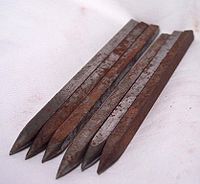- Shurikenjutsu
-
Shurikenjutsu
(手裏剣術)
Focus Weaponry (Shuriken) Hardness Non-competitive Country of origin  Japan
JapanCreator unknown Parenthood ancient Olympic sport No Shurikenjutsu (手裏剣術 literally: "sword hidden in the hand techniques") is a general term describing the traditional Japanese martial arts of throwing shuriken, which are small, hand-held weapons used primarily by the shinobi in feudal Japan, such as metal spikes bō shuriken, circular plates of metal known as hira shuriken, and knives (tantō).[1]
Shurikenjutsu was usually taught among the sogo-bugei, or comprehensive martial arts systems of Japan, mostly in ninjutsu, as a supplemental art to those more commonly practiced such as kenjutsu, sojutsu, bōjutsu and kumi-uchi (battlefield grappling) or jujutsu, and is much less prevalent today than it was in the feudal era.[1]
Contents
History
The origins of shurikenjutsu are shinobi in origin, as there is a lack of reliable documentation regarding the art's history when compared to other arts. However, there are various oral traditions peculiar to each school (Ryu), that describe how their art developed and came to be used within their system.
The art possesses many originators and innovators who discovered and developed their own various methods of adapting everyday objects into throwing weapons, hence the wide variety of both schools and blades. Furthermore, the art itself is typically quite secretive, as shurikenjutsu gains its tactical advantage by using stealth and surprise. Shuriken are small and easily concealed, yet they have the versatility of being used as a stabbing weapon at close range (called shoken if used in this manner), as well as a longer range thrown weapon).[2]
Types of shuriken
Main article: ShurikenShuriken consist of two basic designs:
- Bo-shuriken - straight metal spikes, usually 4-sided but sometimes round or octagonal. They were normally single-pointed but variations exist that are double pointed. The average length was 16 cm and the average weight was around 50 grams. The bo shuriken is thrown by holding it in the palm with the shaft resting between the first and second fingers. They are thrown from either hand, overhand, underhand, or sidearm from standing, seated, and lying positions. This is the most common form of shuriken used in traditional shurikenjutsu.[2]
- Hira-shuriken, shaken (or "throwing stars") - flat, wheel-shaped plates of metal, with sharpened points. Usually 3 mm thick or less, about 11 cm wide, with a variety of tips ranging between 3-20. The hira-shuriken can be thrown either from overhead, or horizontally with a quick wrist-snap, depending on the weapon.[2]
Modern practice
With the abolition of swords during the Meiji period, shurikenjutsu saw a major decline, along with many classical martial arts, and almost died out after the turn of the 20th century as Japan sought to become modernized. In fact, many styles of shurikenjutsu became extinct. If it were not for the efforts of several individuals such as Kanji Naruse (188? - 1948) and Fujita Seiko (1900 - 1966) shurikenjutsu practitioners who preserved the art by transmitting it and writing books on the subject, as well as a handful of surviving classical martial arts schools such as Yagyu Shingan Ryu, Yagyu Shinkage Ryu, Katori Shinto Ryu, Kukishin Ryu and Takeda Ryu Nakamura Ha, Togakure Ryu the art of shurikenjutsu would indeed have been lost to history.
Two schools specifically devoted to shurikenjutsu exist, Negishi Ryu and Meifu Shinkage-ryū.
References
- ^ a b Ratti, Oscar; Adele Westbrook (1991). Secrets of the samurai: a survey of the martial arts of feudal Japan. Tokyo: Tuttle martial arts. p. 328. ISBN 9780804816847.
- ^ a b c Mol, Serge (2003). Classical weaponry of Japan: special weapons and tactics of the martial arts. Tokyo: Kodansha International. pp. 159–160. ISBN 9784770029416.
Further Reading
- Finn, Michael (1983) Art of Shuriken Jutsu Paul Crompton, UK
- Feldmann, Thomas (2010) Interview with Soke Yasuyuki Ôtsuka in "Toshiya" No. 1, 2010, pp.32-35
- Hammond, Billy (1985) Shuriken jutsu: The Japanese art of projectile throwing A.E.L.S , Japan ASIN B0007B60TC
- Fujita, Seiko (1928) Zukai Shurikenjutsu
- Iwai, Kohaku (1999) Hibuki no Subete ga Wakaru Hon (Hidden Weapons) BAB, Japan
- Kono, Yoshinori (1996). Toru Shirai: Founder of Tenshin Shirai Ryu in "Aikido Journal" #108
- Nawa, Yumio (1962) Kakushi Buki Soran (An Overview of Hidden Weapons) Japan
- Saito, Satoshi in Skoss, Diane ed. (1999) Sword & Spirit: Classical Warrior Traditions of Japan Vol. 2 Koryu Books,
- Shirakami, Eizo (1985) Shuriken-do: My study of the way of Shuriken, Paul H. Crompton, London
- Someya, Chikatoshi (2001) Shuriken Giho Airyudo, Japan
- Otsuka, Yasuyuki (2004) Shuriken no Susume BAB, Japan
Martial arts Regional origin Unarmed Weapons Training Grappling Folk wrestling · Brazilian Jiu-Jitsu · Catch Wrestling · Judo · Lucha Libre · Shoot wrestling · Greco-Roman wrestling · Freestyle wrestling · JujutsuFull contact sports Bare-knuckle boxing · Boxing · Full contact karate · Kickboxing · Mixed martial arts · Muay Thai · Sanshou · Shooto · Sambo · TaekwondoSelf-defense/Combatives Entertainment Categories:
Wikimedia Foundation. 2010.
